This year marked the start of a new event, the Camera and Photo Imaging Show, at the Pacifico Yokohama exhibition hall. I can see from the updated Web site, which is at cpplus.jp, that they had around 41,000 visitors over the four days of the event, which I guess isn’t bad for a new show. The day I visited, March 13th, had the most visitors with almost 13,000. It wasn’t particular crowded when I was there, but I left at just after noon for some Canon Video Seminars nearby, that I’ll talk about later.
The show was free to attend if you registered in advance, and I arrived just as they opened at 10AM. I shot images with my iPhone, so that I could upload to Twitter as I went around the show. If you don’t already follow me on Twitter, and would be interested in these kinds of updates, please do follow me, as I rarely announce that I’m going to do this sort of thing beforehand. I chose the 1D Mark IV as my DSLR, because I wanted the good quality high ISO images, and I also knew that I wasn’t going to need the highest resolution possible.
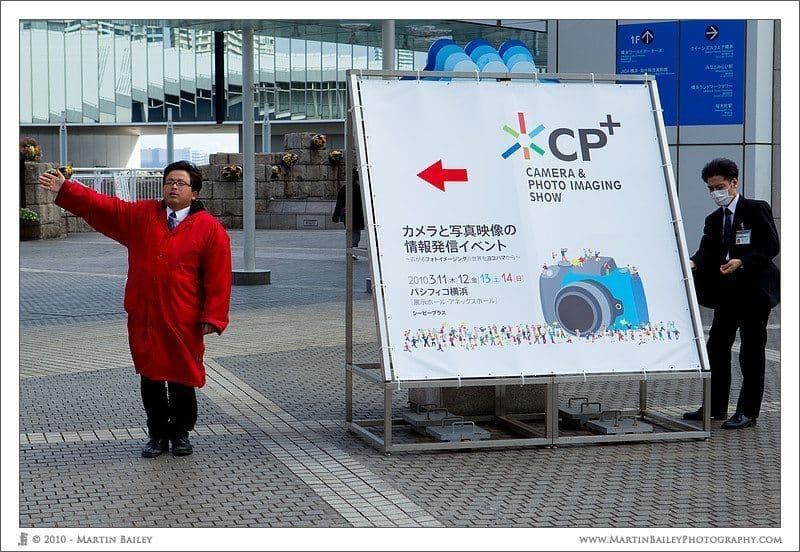
Welcome to CP+ 2010
As I entered the exhibition hall, the first stall to my right was the Epson stand, and then in front of that was the huge Canon stand. Although Epson were the closest, the Canon stand was the first to come into sight. I got a distinct feeling that Canon put a lot into this new show. I tweeted an iPhone image of part of the stand, with all of the big white lenses that Canon usually lines up for people to look through, and we can see from the image that they were also making a point of their 50 millionth EF lens sale, from 1987 to 2009. Which reminds me, I pick up my new 70-200mm F2.8 version II lens hopefully this coming Friday, the 19th of March, and if possible, I’ll be reviewing this lens in comparison to the old version in next week’s Podcast and blog post, so stay tuned for that if you are interested.
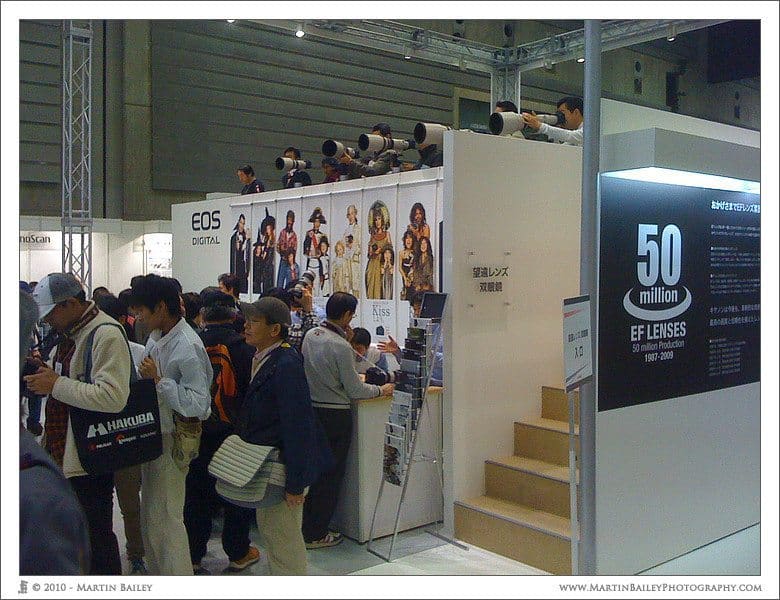
Canon Stand with Big Gun White Lenses
As you can see from the next picture, Canon also put on their usual slew of models for people to shoot, using their own camera or the ones provided. It’s probably no surprise that the big gun white lenses are also pointing this way. There was also an area behind the stand, like a large L shape surrounding the two areas I just showed you, where Canon was showing their cameras and printers. They had the new iPF6350 and iPF 6300, 24″ printers on display. I’m still very interested in this format, to enable me to do my own large prints, but as I mentioned last year, I have to move apartments first, and that is taking me longer than expected. 🙁
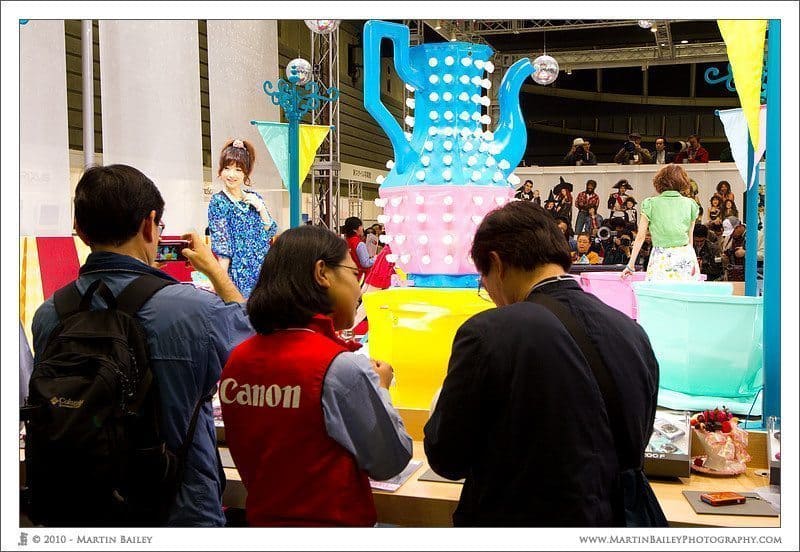
Canon Stand
It was nice to see some large prints, including canvases that Canon had done with their wide roll paper printers. Being a fan of the large print, it got me all the more fired up about wanting to move and get myself one of these big printers. I asked one of the Canon reps if they had any intention to remove the silly borders that they enforce on the user when printing to their fine art papers from the Pro 9500 series printers, and he didn’t have a clue. That’s to be expected of course. I told them that I’d provided the photography community with a workaround, which has been popular, and that Canon are probably losing at least some sales because of this restriction. He politely thanked me for the feedback, and of course I know that he will forget this the moment I walk away. But, I feel that I have a moral duty to tell Canon that this was a very silly idea, whenever I get the chance.
From the front of the Canon stand as you face it, if you swung around to your left, you could see the Olympus stand, and they were of course pushing the new Pen camera, and then after that there was the Nikon stand. Probably about two thirds the size of the Canon stand, and with the slightly less prominent position, Nikon didn’t seem quite as willing to invest in the event.It’s hard to say if this is a good thing or a bad thing. It was the first year for this event after all, and maybe Nikon even feel that they don’t have to invest in events like this, and they’ll still sell lots of cameras.
As we can see from the pretty bad iPhone image that I shot here, instead of models revolving slowly on a merry-go-round, Nikon put on a colorful bush like flower arrangement for their visitors. I actually shot this with one of the DSLRs that they had on display, and it was great for seeing how well the LCD displayed the colors that the camera had captured so well, so I don’t really want to make fun of this. They obviously put a lot of thought into it. It certainly came across as being just slightly cheap-skate compared to the Canon stand though.
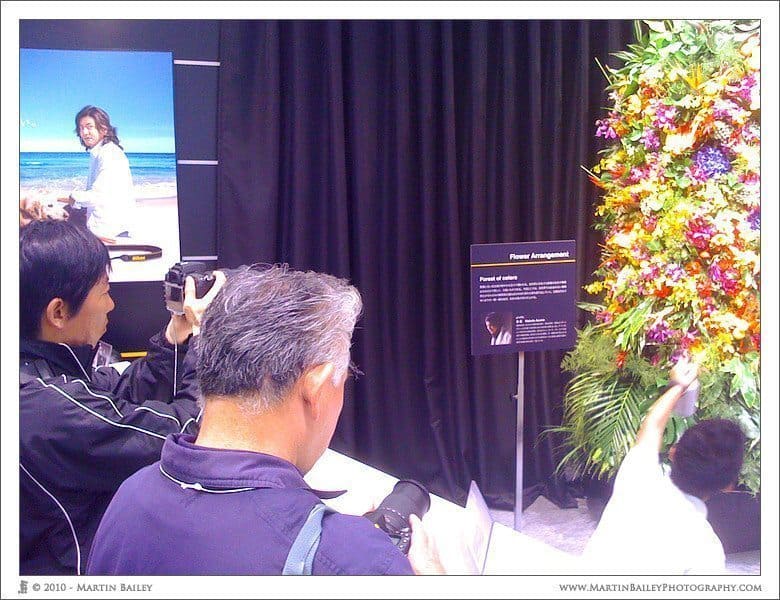
Nikon Stand
Right in front of the Nikon stand was the Gitzo and Manfrotto stand. This was actually a small island with Gitzo and Manfrotto on one side, and Kata Camera Bags on the other side. I was disappointed again in the reply from the Gitzo rep when I asked if there was anywhere in Japan that I could get the zips on my Gitzo jacket replaced, because they keep jamming, and he didn’t have a clue.
I have been planning to buy a Manfrotto fluid head for video though, and found the Manfrotto rep very helpful. He knew roughly what weight each of their fluid heads would support, I thought it was great that he could walk me through to the Gitzo room next to theirs, and explain exactly what I would need to mount their 519 Pro Video Fluid Head to a Gitzo Tripod. The he told me that I’d need a 75mm bowl adapter, and a Systematic Tripod. When I got home it made it very easy for me to find what I needed on the B&H Web site, so full marks to Manfrotto here.
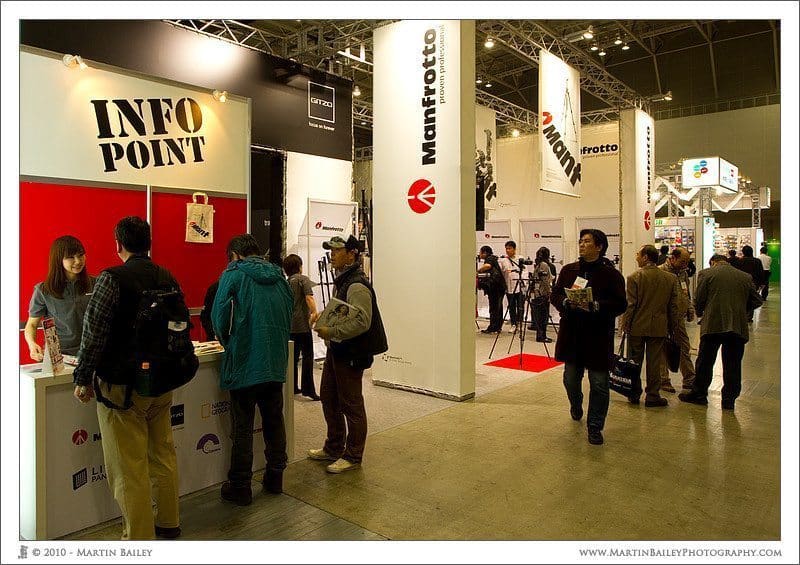
Manfrotto and Gitzo Stand
After this, I went around to the other side of this stand, and found the Kata Camera Bag people. I had heard a lot of good things about the Kata bags, and so decided to take a closer look, and was greeted by a helpful rep called Bellina. I had my Zoom H2 digital recorder with me, and although there isn’t much point in me recording conversations in Japanese for this Podcast, because Bellina spoke English, after speaking for a while we decided to record a quick interview. So I’m going to insert that here, and then we’ll come back and I’ll talk a little more about my impressions of the Kata Camera Bag line of products.
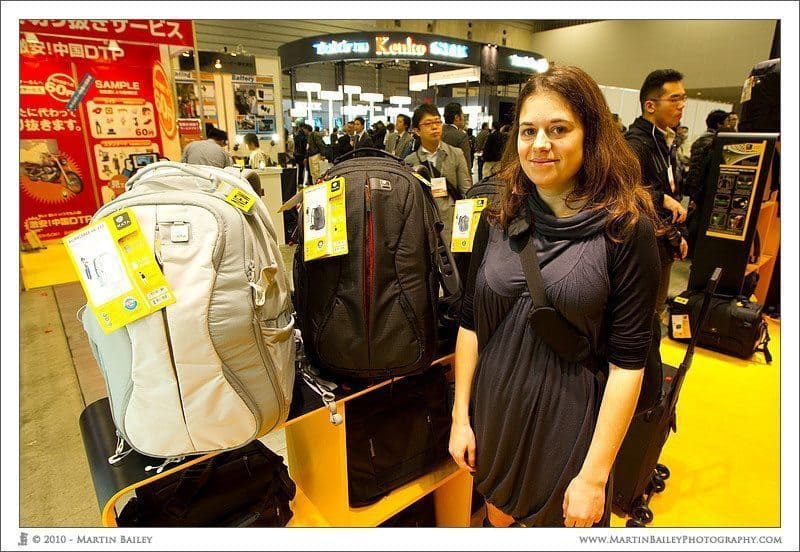
Bellina from Kata Bags
<<Here I play an interview with Kata Bags, so there’s no transcript. Listen to or download the audio at the bottom of this post>>
It was nice to chat with Bellina, and I was pleased to be able to record that for you guys. I really was very impressed with Kata Camera Bags, and can’t wait to get a hold of one or two of these and bring you a full review. From what I saw, they are light, well designed and well made. As Bellina said, they design their bags first and foremost around the person that is the photographer, and not around the gear, and I really think they are on to a winner.
Here’s something else that’s really cool too. If you go to the Kata web site at kata-bags.com, click on the photo link, you will see their Photo Bag Navigator. Here you can narrow down your choices with a number of variables, and the thing that I found most cool was that they list most laptop models from all of the main manufacturers. I have an Acer 9620, and could quickly see which bags I can chose from if I want to carry my laptop as well as my camera gear, and I can tell you, the HB-207 ruck sack style bag is looking pretty tempting.
I don’t carry my laptop that often though, and for when I also won’t be carrying so much of my gear, the new 3N1-33 that Bellina showed me and was wearing in the “X” Position in the photo I posted on my blog, is totally amazing. The way you can wear and carry the bag is so many different configurations, and the layout of the pockets for quick access to your camera and lenses, as well as the space for and access to your personal belongings is awesome.
I actually didn’t have much time to walk the floor at the CP+ show, because I’d registered to attend three Canon seminars that turned out to be just down the road from the show, in a different building. I had maybe another 30 minutes after talking to the Kata folks, so I continued to walk around, and looked at the Lite Panels that were available, including ones with White Balance control on the back, which was pretty impressive. I found that they could also be controlled by a central control unit, rather than going to each light. It didn’t seem possible to control them from a laptop PC or anything though, which I thought would have been better than making the user buy a separate control unit, but I guess that’s a good marketing strategy.
Canon EOS Movie Seminars
I left the exhibition hall at just after midday, and grabbed a sandwich at the convenience store, then walked the 10 minutes down the road to the Canon EOS Movie Seminars, which were to be held at the Brillia ShortShorts Theater. The first seminar I watched was by a photographer and videographer name Juumonji Bishin. For the most part, I’d seen the video that was being played, and although beautiful, was starting to feel a little bit disappointed that the seminar was really just rehashing stuff that had already been published.
Then Bishin started talking about his experiences when Canon first came to him with the 5D Mark II when it was still in prototype. Apparently they asked him to take the new camera out and get some photographs for their marketing, to show how good the camera was, but before he left, they said, by the way, this camera can shoot full High Definition video. If you have time to get a few video clips as well, that would be great! Because Bishin has a lot of experience with video, and has used film HD camera for a number of years, he said that he was excited because he immediately realized that the full sized sensor in the 5D Mark II would give him much more ability to shoot with a shallow depth-of-field, compared to even the largest 35mm film HD video cameras, at half the size. He also said that he simply couldn’t stand digital HD cameras, because the sensors are so ridiculously small.
He went on though to show us what is probably the first DSLR Video shot in the world, outside of what the Canon R&D team would have obviously shot during the development and testing of the camera. It was a small patch of equinox flowers in the rain. It was a simply 15 to 30 second clip, that he says he just shot between shooting stills, to see how it looked. It turned out to be one of the most beautiful, what I call “moving stills” that I’ve seen. The way the rain hit the long tendrils of the equinox flowers, making them bend down then spring back up again, and the light was amazing. I love shooting in the rain, so I was maybe more responsive to this, but it really was a beautiful clip, and to see it on a full sized movie theater screen was great.
I’ve been shooting this sort of moving still for a while now, and have a number of them from Hokkaido as well that I will share with you soon, but having already gotten the bug to start to do more of this, and after being inspired by one of this year’s Hokkaido workshop participants, I really enjoyed this clip, and started to feel happy that I’d attended. After all, it was getting the video bug that made me decide to sign up for these seminars, and I’ve actually just placed an order for a Manfrotto 519 Pro Video Fluid Head and some other things from Really Right Stuff to hopefully rig up my cameras so that I can drop them onto a video head easily without having to remove my RRS Arca Swiss type plates. My main focus will remain stills, but I hope you aren’t going to mind if I talk about video a little bit more in the coming months as I get more into this.
The second seminar that I attended was called “EOS Movie Practical Techniques from a Pro Photographer. These guys spent a lot of time talking about the new plug-in for Final Cut Pro that will basically enable people to convert video to a better format much quicker than has been possible so far. One of the take-aways was seeing how they used LiveView on a laptop PC and a second HDMI monitor coming straight out of the camera, to accurate focus and view the video stream on a large screen as they shot. I hadn’t realized that you can attach something like the Manhattan 8.9” HD monitor screens to the camera and use it for LiveView, and although I knew that you could use LiveView on a Laptop using the EOS Utilities, I hadn’t really thought of using this for video until now, so this was good information for me.
Probably my biggest take-away here was when they showed some 60fps video played back at 30fps. I knew about this technique, and rather than it looking like slow motion, it just had a dreamy feel to it. I thought that was entirely down to the shallow depth-of-field being used, but then they said that this is how we view our memories. Basically, when we look at something with interest, and commit it to memory, then recall it later, it is played back to us slower than the actual scene was, and this clicked with me instantly. The footage they showed seemed like the recollection of a precious memory.
The last seminar that I attended was on tips and techniques from a music video director. I almost didn’t sign up for this one, and I almost of wished I hadn’t. There were a few things that I enjoyed, like watching how the director works with the photographer and seeing the gear that they were using. Again, they had Manhattan HD Monitors and PCs hooked up to the camera, and using all sorts of gear to get their video footage. They also gave a lot of background information on the video that they did called “the passage”, which you can see on the Canon web site at the moment as well. They said that when they chose the young Italian model for this video, the agent had told them that she had loads of video experience, and when they turned up to start shooting she said it was her first video job, which I thought was quite funny.
Anyway, a relatively enjoyable afternoon, although Canon’s handling of the logistics could have been better, and I wished it hadn’t been so far from the main exhibition hall so that I could have gone back, but in general I’m pleased I went. My one complain about the whole thing is that it’s too short. The doors open at 10AM and close at 5PM, so if you want to attend some seminars as well, there really isn’t enough time to talk to many of the exhibitors. I got to all of the stands that I was interested in, but if I’d had a few more hours, I could have looked at a few more stands in more detail, to see if I could find any other hidden gems.
Podcast show-notes:
CP+ Web site: http://cpplus.jp/
Kata Bags: http://www.kata-bags.com/
The new Kata 3N1-33 Sling Backpack: [Removed invalid link]
WebSpy giveaway: http://www.webspy.com.au/blogs/index.php/new-webspy-soho-giveaway/
Music from Music Alley: http://www.musicalley.com/
Audio
Download the Enhanced Podcast M4A files directly.


This was really a great exhibition I have ever seen. I think this is the best way to present the best capturing device of this world. Keep posting
Wholesale NFL Jerseys,choose NFL Jerseys in our web,they are complete in styles,custom nfl jerseys,here will be right place to get these NFL Jerseys
The invention of bag making machine is convenient like non woven bag making machine, and
especially do favor with those consumers who are usually go out. It designed like a tubular bag
packing with a low width. For such type of stretch film rewinding machine which is
longitudinally sealed by an inner seal strip of their packing foil butt edges.